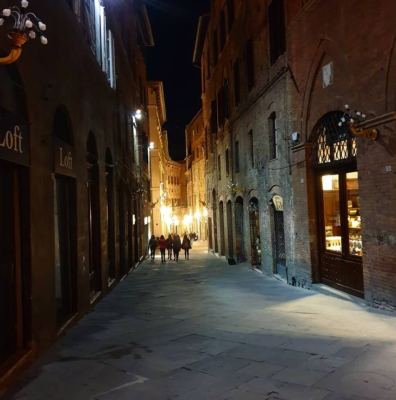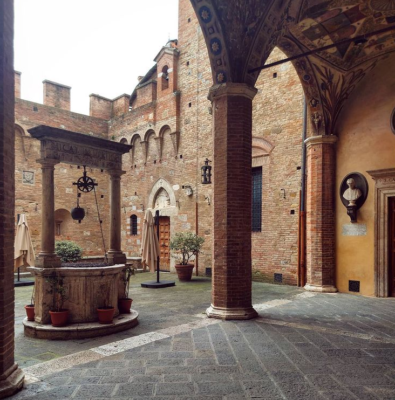Via di Citta
On the back side of the Museum of Torture, the most elegant and stately street of the historic center, the Via di Citta runs across the whole western perimeter of Piazza del Campo. Via di Citta is lined with an almost uninterrupted curtain of medieval palaces. The most notable of them are the Palazzo Patrizi in Via di Città 75, home of the Accademia Intronati, founded in 1525 as a meeting place for the city’s aristocracy, today a civic association for the promotion of the study of the history and arts of the Sienese region.
A few steps away, in Via di Città 89, the Palazzo Marescotti, was erected in the mid-twelfth century for the aristocratic Marescotti family. Their emblem (an eagle with outstretched wings) is still visible on the trefoil windows of the facade. The palazzo passed to the Piccolomini-Mandoli family in the 16th century and successively to the Saracini in the 18th century. In 1877 the building became Palazzo Chigi-Saracini and after 2014 it houses the Accademia Musicale Chigiana.



The palazzo opens its doors to visitors who can discover, through the testimonies preserved there, the story of some of the most prestigious families of the Sienese nobility. You can admire one of the most important Italian private collections commissioned by Galgano Saracini. , Galgano Saracini gathered with great taste and intelligence, between the late 18th and early 19th century, paintings, marble and terracotta sculptures, carvings, porcelain, precious ivory and wooden creations, precious stones, porcelains and ceramics. The precious objects came from the most important Italian schools from the sixteenth to the eighteenth century, creating a unique art gallery of its kind.
The rooms of the Palazzo are packed with furnishings, wall paintings, fabrics, and wallpaper, witnesses of the exquisite taste of Galgano Saracini, of his late romantic son Alexander and, above all, the eclecticism of the last heir, Count Guido Chigi Saracini, last descendant of the two noble families and sole recipient of their fortunes.
The great patron of arts, Guido Chigi Saracini founded 1932 the Accademia Musicale Chigiana, a high school for musical improvement, employing as teachers some of the most important musicians of the time such as Pablo Casals, Andres Segovia, etc. The testimony of the passage to the Palace of the great artists of the twentieth century is documented by a series of photos on display.
As in the time of the Count, on tables, consoles, and in some rooms, next to the concert hall built by Arturo Viligiardi, you can see also rare examples of musical instruments. The Palazzo Chigi Saracini is therefore all these with the Accademia Musicale Chigiana Foundation, together with Banca Monte dei Paschi di Siena, now being the owners of the biggest part of the art collection, that is now available to the public.




